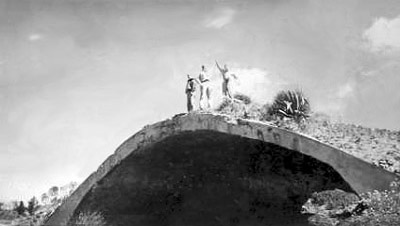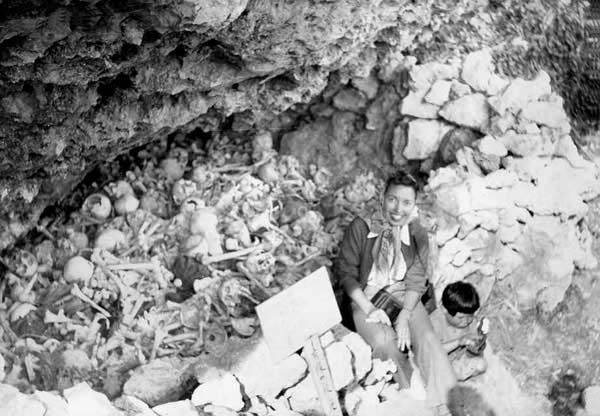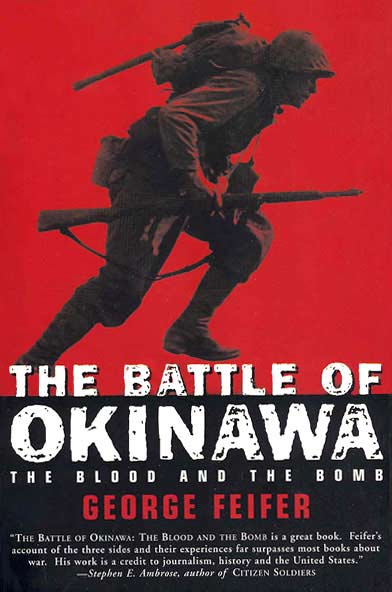BOOK REPORT
THE BATTLE OF OKINAWA
THE BLOOD AND THE BOMB
|
Author: George Feifer |
The Battle for Okinawa can be described in the grim superlatives of war. In size, scope and ferocity, it dwarfed the Battle of Britain. Never before had there been, probably never again will there be, such a vicious sprawling struggle of planes against planes, of ships against planes. Never before, in so short a space, had the Navy lost so many ships; never before in land fighting had so much American blood been shed in so short a time in so small an area: probably never before in any three months of the war had the enemy suffered so hugely, and the final toll of American casualties was the highest experienced in any campaign against the Japanese. There have been larger land battles, more protracted air campaigns, but Okinawa was the largest combined operation, a "no quarter" struggle fought on, under and over the sea and land.
By Hanson W. Baldwin, Military Historian
Okinawa was the site of the largest land-sea-air battle in history. It was a turning point in modern history. The Kamikaze caused the Navy greater casualties than any previous engagement in either the Atlantic or the Pacific. More than twice the number of Americans were killed and wounded on Okinawa than on Guadalcanal and Iwo Jima combined. Okinawa's civilian tragedy exceeded that of Hiroshima. Some 150,000 died a more horrible death than those burned under the mushroom cloud.
It was on March 25, 1945 when the huge fleet of American warships closed on Okinawa. This book, containing 492 pages unquestionably exposes the horrible price both sides paid in the coming attack. Kamikaze operations had already started against the fleet carrying out the pre-invasion bombardment. Admission of defeat would never be considered by the Japanese. The war was just getting underway when the largest battleship afloat, the Yamato, was sunk by a massive American attack. George Feifer goes into great detail explaining the history of Okinawa, their culture, their relationship with the Japanese military, and the determination of the Kamikaze warriors. He covers the war in minute detail, of the landings, civilian casualties, and the extreme violence. The Japanese reported 2,944 Kamikaze planes lost. At one time the whole ocean appeared to be on fire as the suicide planes crashed into the American ships. Admiral Onishi was given overall charge of the mass Kamikaze attacks. By now the Japanese were using special attack weapons including crash boats, human mines, and human torpedos. Midget submarines did not live up to the Japanese expectations. The most deadly weapon was the Ohka (exploding cherry bomb). This was actually a flying torpedo, a rocket powered bomb released from a converted bomber. 185 planes used in the Ohka attacks were destroyed. The young pilots considered death in combat as a pure and fitting end. Our carriers lost 539 planes, 33 ships were sunk, over half by Kamikaze and 368 ships damaged, more than 50 seriously. The Japanese loss was staggering, loosing a total of 7,830 planes in three months. The final toll of Naval casualties over the course of the campaign would be 4,907 killed or missing, and 4,824 wounded. On June 21, Lt. Gen. Ushijima Mitsuru surrendered Okinawa to the U.S. He committed suicide the next day. Still Japan refused to concede that WWII was over. Surrender was an unthinkable dishonor.
I was fascinated with the fairness of the coverage of activities of both sides. The Americans themselves were involved in a large amount of atrocities, so vividly described. This is truly the finest authoritative documentary of the Battle of Okinawa ever written. It provides an unforgettable picture of men at war and also the context for understanding one of the most ominous events of the century: the decision to drop the bomb. I cannot heap enough praise on this publication. May I suggest that everyone should read it, and remember its message. An attack on the Japanese mainland would have cost several million lives, American and Japanese. With the fanatical Japanese willing to fight to the death of the last man, did the bomb actually save lives by not having to invade?
 Underground Hangar. Crops were planted on top rendering it virtually impossible to see from the air. - Ctsy. Wayland Mayo |

Suicide Cliff where thousands of Japanese commited suicide, soldiers and civilians.
Ctsy. Wayland Mayo
